Bishop of Bath and Wells
| Bishop of Bath and Wells | |
|---|---|
| Bishopric | |
| anglican | |
|
Arms of the Bishop of Bath and Wells: Azure, a saltire per saltire quarterly quartered or and argent[1] | |
|
Incumbent: Peter Hancock | |
| Province | Canterbury |
| Diocese | Bath and Wells |
| Cathedral | Wells Cathedral |
| Residence | Bishop's Palace, Wells |
| First incumbent | Athelm |
| Formation | 909 |
| Website |
www |
The Bishop of Bath and Wells heads the Church of England Diocese of Bath and Wells in the Province of Canterbury in England.
The present diocese covers the vast majority of the (ceremonial) county of Somerset and a small area of Dorset. The Episcopal seat is located in the Cathedral Church of Saint Andrew in the city of Wells in Somerset.
The current bishop, since his confirmation of election on 4 March 2014,[2] is Peter Hancock,[3][4] the seventy-eighth Bishop, who signs Peter Bath: et Well:. He fully took up his duties upon his installation in a service at Wells Cathedral on 7 June 2014.[5] The see had been vacant since Peter Price's retirement on 30 June 2013, during which time Peter Maurice (Bishop suffragan of Taunton) had acted as diocesan bishop.[6]
The Bishop's residence is The Palace, Wells. In late 2013 the Church Commissioners announced that they were purchasing the Old Rectory, a Grade II-listed building in Croscombe for the Bishop's residence.[7] However this decision was widely opposed,[8] including by the Diocese,[9][10] and in May 2014 was overturned by a committee of the Archbishops' Council.[11][12]
History
Somerset originally came under the authority of the Bishop of Sherborne, but Wells became the seat of its own Bishop of Wells from 909. King William Rufus granted Bath to a royal physician, John of Tours, Bishop of Wells and Abbot of Bath, who was permitted to move his episcopal seat for Somerset from Wells to Bath in 1090, thereby becoming the first Bishop of Bath. He planned and began a much larger church as his cathedral, to which was attached a priory, with the bishop's palace beside it.
In 1197 Bishop Savaric FitzGeldewin officially moved his seat to Glastonbury Abbey with the approval of Pope Celestine III. However, the monks there would not accept their new Bishop of Glastonbury and the title of Bishop of Bath and Glastonbury was used until the Glastonbury claim was abandoned in 1219. His successor, Jocelin of Wells, then returned to Bath, again under the title, Bishop of Bath. The official episcopal title became Bishop of Bath and Wells under a Papal ruling of 3 January 1245.
By the 15th century Bath Abbey was badly dilapidated. Oliver King, Bishop of Bath and Wells, decided in 1500 to rebuild it on a smaller scale. The new abbey-church was completed just a few years before Bath Priory was dissolved in 1539. Then Henry VIII considered this new church redundant, and it was offered to the people of Bath to form their parish church; but they did not buy it, and it was stripped of its glass and lead.[13] The last bishop in communion with Rome was deprived in 1559 but the succession of bishops has continued to the present day.
The diocese and the episcopate are today part of the Anglican Communion.
In popular culture
Fictional bishops of this title repeatedly appear in the BBC television comedy Blackadder, in which the bishop is portrayed as an obese, blasphemous, self-confessed pervert who eats children.[14][15][16] Others are mentioned in at least two skits by Monty Python[17] and yet another in the BBC radio comedy Absolute Power. Neil Gaiman's 2008 work The Graveyard Book features a character named the Bishop of Bath and Wells – he is one of a trio of ghouls who spirit the main character away.[18][19]
List of bishops
Pre-Reformation bishops
| Bishops of Wells | |||
|---|---|---|---|
| From | Until | Incumbent | Notes |
| c. 909 | c. 923–925 | Athelm | Formerly a monk at Glastonbury Abbey. Consecrated circa 909. Translated to Canterbury between 923 and September 925. |
| c. 923–925 | c. 926–928 | Wulfhelm | Consecrated between circa 923 and 925. Translated to Canterbury between January 926 and 928. |
| c. 926–928 | 937 or 938 | Alphege | Consecrated between January 926 and 928. Died in office. Also recorded as Ælfheah. |
| 937 or 938 | 956 | Wulfhelm II | Consecrated in 937 or 938. Died in office. |
| 956 | 973 | Byrhthelm | Formerly a monk at Glastonbury Abbey. Consecrated in 956. Translated to Canterbury in 959, but deposed and translated back to Wells in the same year. Died in office on 15 May 973. |
| 973 or 974 | 975 | Cyneweard | Formerly Abbot of Milton. Consecrated in 973 or 974. Died in office on 28 June 975. |
| c. 975–979 | 996 | Sigar | Formerly Abbot of Glastonbury (c. 970–975). Consecrated between 975 and 979. Died in office on 28 June 996. |
| 996 | 998 or 999 | Ælfwine | Consecrated in 996 or 997. Died in office on 29 August in 998 or 999. |
| 998 or 999 | 1013 | Lyfing | Formerly Abbot of Chertsey Abbey. Consecrated in 998 or 999. Translated to Canterbury in 1013. |
| c. 1013–18 | c. 1021–24 | Aethelwine | Consecrated between 1013 and 1018. Expelled circa 1021/1023 and 1024 in favour of Brihtwine. |
| c. 1021–24 | unknown | Brihtwine | Expelled. |
| unknown | unknown | Aethelwine (again) | Restored but expelled a second time. |
| unknown | before 1024 | Brihtwine (again) | Restored. Died in office before 1024. |
| before 1024 | 1033 | Merewith | Consecrated before 1024. Died in office on 11 or 12 April 1033. |
| 1033 | 1060 | Dudoc | Consecrated on 11 June 1033. Died in office on 18 January 1060. |
| 1061 | 1088 | Gisa | Previously chaplain to King Edward the Confessor. Elected bishop after 18 January 1060 and consecrated on 15 April 1061. Died in office in 1088. Also recorded as Giso. |
| 1088 | 1090 | John of Tours | Consecrated Bishop of Wells in July 1088. Became Bishop of Bath when he moved the see from Wells to Bath in 1090. |
| Bishops of Bath | |||
| From | Until | Incumbent | Notes |
| 1090 | 1122 | John of Tours | Moved the see from Wells to Bath in 1090. Died in office between 29 and 30 December 1122. Also recorded as John de Villula. |
| 1123 | 1135 | Godfrey | Formerly chaplain to Queen Consort Adeliza. Nominated on 25 March and consecrated on 26 August 1153. Died in office on 16 August 1135. |
| 1136 | 1166 | Robert | Previously a monk at Lewes Priory. Consecrated on 22 March and received possession of the temporalities circa 22 March 1136. Died in office on 31 August 1166. |
| 1166 | 1174 | See vacant | |
| 1174 | 1191 | Reginald fitz Jocelin | Previously Archdeacon of Wiltshire. Elected bishop in late April 1173 and consecrated on 23 June 1174. He became Archbishop-elect of Canterbury on 27 November 1191, but before appeals against his election were heard, he died on 26 December 1191. |
| 1192 | 1197 | Savaric FitzGeldewin | Formerly Archdeacon of Northampton (1175–1192). Elected bishop by the monks of Bath Abbey between 27 November and 26 December 1191 and consecrated on 20 September 1192. Also became Abbot of Glastonbury in 1193. He moved the Episcopal seat from Bath to Glastonbury in 1197. |
| Bishops of Bath and Glastonbury | |||
| From | Until | Incumbent | Notes |
| 1197 | 1205 | Savaric FitzGeldewin | After moving the Episcopal seat from Bath to Glastonbury in 1197, he was styled Bishop of Bath and Glastonbury. Died in office on 8 August 1205. |
| 1206 | 1219 | Jocelin of Wells | Previously Canon of Wells. Elected bishop on 3 February and consecrated on 28 May 1206. He was styled Bishop of Bath and Glastonbury until 1219, thereafter Bishop of Bath. |
| Bishops of Bath | |||
| From | Until | Incumbent | Notes |
| 1219 | 1242 | Jocelin of Wells | Previously styled Bishop of Bath and Glastonbury until 1219, thereafter Bishop of Bath. Died in office on 19 November 1242. |
| 1242 | 1244 | See vacant | |
| 1244 | 1245 | Roger of Salisbury [20] | Formerly Precentor of Salisbury (1227–1244). Elected bishop by the monks of Bath Abbey on 6 February 1243 and consecrated on 11 September 1244. Became Bishop of Bath and Wells on 3 January 1245. |
| Bishops of Bath and Wells | |||
| From | Until | Incumbent | Notes |
| 1245 | 1247 | Roger of Salisbury [20] | Following a papal ruling, the episcopal title changed to Bishop of Bath and Wells on 3 January 1245. Died in office on 21 December 1247. |
| 1248 | 1264 | William of Bitton I | Formerly Archdeacon of Wells (1238–1248). Elected bishop before 24 February and consecrated on 14 June 1248. Died in office on 3 April 1264. |
| 1265 | 1266 | Walter Giffard | Elected bishop on 22 May 1264 and consecrated on 4 January 1265. Also Lord Chancellor (1265–1266). Translated to York on 15 October 1266. |
| 1267 | 1274 | William of Bitton II | Formerly Archdeacon of Wells (c. 1263–1267). Elected bishop on 10 February and consecrated after 17 April 1267. Died in office on 4 December 1274. |
| 1275 | 1292 | Robert Burnell | Formerly Archdeacon of York (1270–1275). Elected bishop on 23 January and consecrated on 1275. Became Archbishop-elect of Canterbury (1278–1279) and Bishop-elect of Winchester (1280). Also Lord Chancellor (1274–1292). Died in office on 25 October 1292. |
| 1293 | 1302 | William of March | Formerly Dean of St. Martin's-le-Grand and Lord Treasurer. Elected bishop on 28 January and consecrated on 17 May 1293. Died in office before 19 June 1302. |
| 1302 | 1308 | Walter Haselshaw | Formerly Dean of Wells (1295–1302). Elected bishop on 7 August and consecrated on 4 November 1302. Died in office on 11 December 1308. |
| 1309 | 1329 | John Droxford | John Drokensford; formerly Keeper of the wardrobe and acting Lord Treasurer. Elected bishop on 5 February and consecrated on 9 November 1309. Died in office on 9 May 1329 |
| 1329 | 1363 | Ralph of Shrewsbury | Elected on 2 June and consecrated on 3 September 1329. Died in office on 14 August 1363. |
| 1363 | 1366 | John Barnet | Translated from Worcester. Appointed on 24 December (or about 28 November) 1363 and received the temporalities on 6 April 1364. Translated to Ely on 15 December 1366. |
| 1367 | 1386 | John Harewell | Previously Chancellor of Gascony and chaplain to the Black Prince. Appointed bishop on 14 December 1366 and consecrated on 7 March 1367. Died in office between 29 June and 14 July 1386. |
| 1386 | 1388 | Walter Skirlaw | Translated from Coventry & Lichfield. Appointed on 18 August and received the temporalities on 3 November 1386. Translated to Durham on 3 April 1388. |
| 1388 | 1400 | Ralph Ergham | Translated from Salisbury. Appointed on 3 April and received the temporalities on 13 September 1388. Died in office on 10 April 1400. |
| 1400 | 1401 | (Richard Clifford) | Appointed on 12 May 1400, but, before consecration, translated to Worcester on 19 August 1401. |
| 1401 | 1407 | Henry Bowet | Formerly Canon of Wells. Appointed bishop on 19 August 1401 and consecrated on 20 November 1401. Translated to York on 7 October 1407. |
| 1407 | 1424 | Nicholas Bubwith | Translated from Salisbury. Appointed on 7 October and received the temporalities on 2 December 1407. Died in office on 27 October 1424. |
| 1424 | 1443 | John Stafford | Formerly Dean of Wells (1423–1424). Elected bishop between 14 November and 19 December 1424. Consecrated on 27 May 1425. Also Lord Treasurer (1422–1426) and Lord Chancellor (1432–1450). Translated to Canterbury on 13 May 1443. |
| 1443 | 1465 | Thomas Beckington | Formerly Archdeacon of Buckingham (1424–1443). Appointed bishop on 24 July and consecrated on 13 October 1443. Also the Keeper of the Privy Seal (1443–1444). Died in office on 14 January 1465. |
| 1465 | 1491 | Robert Stillington | Formerly Archdeacon of Taunton (1450–1465). Appointed bishop on 30 October 1465 and consecrated on 16 March 1466. Also intermittently Lord Chancellor between 1460 and 1473. Died in office before 15 May 1491. |
| 1492 | 1494 | Richard Foxe | Translated from Exeter. Appointed on 8 February and received the temporalities on 4 May 1492. Translated to Durham on 30 July 1494. |
| 1495 | 1503 | Oliver King | Translated from Exeter. Appointed on 6 November 1495 and received the temporalities on 6 January 1496. Died in office before 1503. |
| 1504 | 1518 | Cardinal Adriano Castellesi | Translated from Hereford. Appointed on 2 August and received possession of the temporalities on 13 October 1504. Deprived of the see by Pope Leo X on 5 July 1518. |
| 1518 | 1523 | Cardinal Thomas Wolsey | Archbishop of York (1514–1530) and Lord Chancellor (1515–1529). Appointed in commendam the see of Bath and Wells on 27 July 1518, but exchanged it to the see of Durham on 26 March 1523. |
| Sources: [21][22][23] | |||
Bishops during the Reformation
| Bishops of Bath and Wells during the Reformation | |||
|---|---|---|---|
| From | Until | Incumbent | Notes |
| 1523 | 1541 | John Clerk | Formerly Master of the Rolls (1522–1523) and Dean of Windsor (1519–1523). Appointed bishop on 26 March and consecrated on 6 December 1523. Accepted royal supremacy in 1534. Died in office on 31 January 1541. |
| 1541 | 1547 | William Knight | Formerly Secretary of State to Henry VIII (1526–1528) and Prebendary of St Paul's (1517–1541). Nominated bishop on 9 April and consecrated on 29 May 1541. Died in office on 29 September 1547. |
| 1548 | 1553 | William Barlow | Translated from St David's. Nominated on 3 February 1548. Resigned before 4 October 1553. Later became Bishop of Chichester in 1559. |
| 1554 | 1559 | Gilbert Bourne | Formerly Prebendary of St Paul's and Lord President of Wales and the Marches. Nominated bishop on 13 March and consecrated on 1 April 1554. Deprived between 18 October 1559 and 11 January 1560. Died on 10 September 1569. |
| Sources: [23][24][25] | |||
Post-Reformation bishops
| Post-Reformation Bishops of Bath and Wells | |||
|---|---|---|---|
| From | Until | Incumbent | Notes |
| 1560 | 1581 | |
Nominated on 11 January and consecrated on 24 March 1560. Died in office on 2 November 1581. |
| 1581 | 1584 | See vacant | |
| 1584 | 1590 |  Thomas Godwin Thomas Godwin |
Formerly Dean of Canterbury (1567–1584). Nominated bishop on 25 July and consecrated on 13 September 1584. Died in office on 19 November 1590. |
| 1590 | 1592 | See vacant | |
| 1593 | 1608 | _by_Sylvester_Harding.jpg) John Still John Still |
Formerly Master of Trinity College, Cambridge (1577–1593). Nominated bishop on 13 January and consecrated on 11 February 1593. Died in office on 26 February 1608. |
| 1608 | 1616 |  James Montague James Montague |
Formerly Dean of Worcester (1604–1608). Nominated bishop on 21 March and consecrated on 17 April 1608. Translated to Winchester on 4 October 1616. |
| 1616 | 1626 | 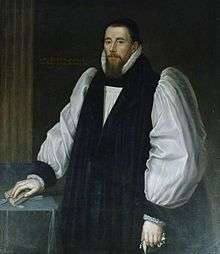 Arthur Lake Arthur Lake |
Formerly Dean of Worcester (1608–1616). Elected on 17 October and consecrated on 8 December 1616. Died in office on 4 May 1626. |
| 1626 | 1628 |  William Laud William Laud |
Translated from St David's. Nominated bishop of Bath & Wells on 20 June and confirmed on 18 September 1626. Translated to London on 15 July 1628. |
| 1628 | 1629 | |
Nominated on 14 July and consecrated on 7 September 1628. Also Master of Trinity College, Cambridge (1625–1628). Died in office on 2 September 1629 |
| 1629 | 1632 | 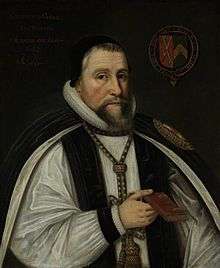 Walter Curle Walter Curle |
Translated from Rochester. Elected on 29 October and confirmed on 4 December 1629. Translated to Winchester on 16 November 1632. |
| 1632 | 1646 | 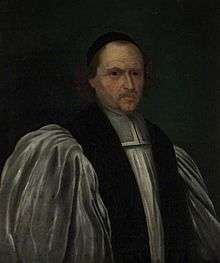 William Piers William Piers |
Translated from Peterborough. Nominated on 19 November and confirmed on 13 December 1632. Deprived of the see when the English episcopy was abolished by Parliament on 9 October 1646. |
| 1646 | 1660 | The see was abolished during the Commonwealth and the Protectorate.[26][27] | |
| 1660 | 1670 |  William Piers (restored) William Piers (restored) |
Returned when the see was restored in 1660. Died in office on 30 April 1670. |
| 1670 | 1672 |  Robert Creighton Robert Creighton |
Formerly Dean of Wells (1660–1670). Nominated on 2 May and consecrated on 19 June 1670. Died in office on 20 November 1672. |
| 1673 | 1684 |  Peter Mews Peter Mews |
Formerly Dean of Rochester (1670–1673). Nominated on 23 November 1672 and consecrated 6 February 1673. Translated to Winchester on 22 November 1684. |
| 1685 | 1690 |  Thomas Ken Thomas Ken |
Formerly Canon of Winchester (1669–1685). Nominated on 24 November 1684 and consecrated on 25 January 1685. Deprived of the see on 1 February 1690 for not taking the oaths to the sovereigns. Died on 19 March 1711. |
| 1691 | 1703 | 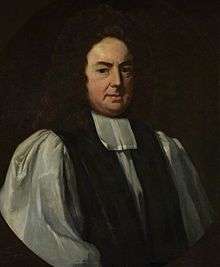 Richard Kidder Richard Kidder |
Formerly Dean of Peterborough (1689–1691). Nominated on 11 June and consecrated on 30 August 1691. Died in office on 26 November 1703. |
| 1704 | 1727 |  George Hooper George Hooper |
Translated from St Asaph. Nominated on 23 December 1703 and confirmed on 14 March 1704. Died in office on 6 September 1727. |
| 1727 | 1743 |  John Wynne John Wynne |
Translated from St Asaph. Nominated on 19 September and confirmed on 11 November 1727. Died in office on 15 July 1743. |
| 1743 | 1773 | 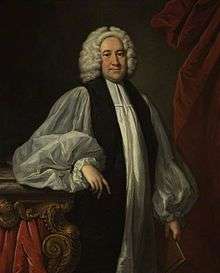 Edward Willes Edward Willes |
Translated from St David's. Nominated on 13 September and confirmed on 12 December 1743. Died in office on 24 November 1773. |
| 1774 | 1802 |  Charles Moss Charles Moss |
Translated from St David's. Nominated on 23 April and confirmed on 2 June 1774. Died in office on 13 April 1802. |
| 1802 | 1824 | 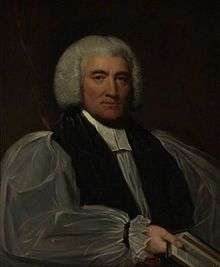 Richard Beadon Richard Beadon |
Translated from Gloucester. Nominated on 27 April and confirmed on 2 June 1802. Died in office on 21 April 1824. |
| 1824 | 1845 |  George Henry Law George Henry Law |
Translated from Chester. Nominated on 8 May and confirmed on 8 June 1824. Died in office on 22 September 1845. |
| 1845 | 1854 |  Richard Bagot Richard Bagot |
Translated from Oxford. Nominated on 15 October and confirmed on 12 November 1845. Died in office on 15 May 1854. |
| 1854 | 1869 | 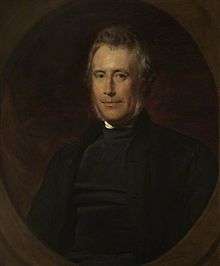 The Lord Auckland The Lord Auckland |
Translated from Bishop of Sodor and Man. Nominated on 2 June and confirmed on 1 July 1854. Resigned as bishop on 6 September 1869 and died on 25 April 1870. |
| 1869 | 1894 | 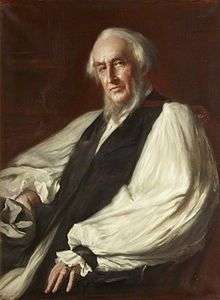 Lord Arthur Hervey Lord Arthur Hervey |
Formerly Archdeacon of Sudbury (1862–1869). Nominated on 11 November and consecrated 21 December 1869. Died in office on 9 June 1894. |
| 1894 | 1921 |  George Kennion George Kennion |
Translated from Adelaide in Australia. Nominated on 24 August and confirmed on 17 October 1894. Resigned on 1 August 1921 and died on 19 May 1922. |
| 1921 | 1937 | |
Nominated on 6 October and consecrated on 1 November 1921. Resigned on 1 October 1937 and died on 15 October 1946. |
| 1937 | 1943 |  Francis Underhill Francis Underhill |
Nominated on 6 October and consecrated on 30 November 1937. Died in office on 24 January 1943. |
| 1943 | 1945 |  William Wand William Wand |
Translated from Brisbane. Nominated on 23 September and confirmed on 27 October 1943. Translated to London on 22 August 1945. |
| 1946 | 1960 | |
Nominated on 5 March and consecrated on 1 May 1946. Died in office on 1 May 1960. |
| 1960 | 1975 | |
Translated from Tewkesbury. Nominated on 1 July and confirmed 19 July 1960. Resigned on 31 May 1975 and died in 1986. |
| 1975 | 1988 | |
Translated from Warrington. Nominated on 15 October and confirmed on 12 December 1975. Also Clerk of the Closet (1979–1989). Retired in 1988. |
| 1987 | 1991 |  George Carey George Carey |
Formerly Principal of Trinity Theological College, Bristol (1982–1988). Nominated and consecrated bishop in 1987. Translated to Canterbury in 1991. |
| 1991 | 2001 | |
Translated from Stepney. Nominated and confirmed in 1991. Retired in 2001 and died in 2003. |
| 2002 | 2013 | |
Translated from Kingston-upon-Thames. Nominated in 2001 and enthroned in 2002.[28] Retired on 30 June 2013. |
| 4 March 2014 | incumbent |  Peter Hancock Peter Hancock |
Translated from Basingstoke. Nominated in December 2013 and installed in June 2014[5] |
| Sources: [25][29] | |||
References
- ↑ Debrett's Peerage, 1968, p.121
- ↑ Diocese of Bath and Wells – Bishop's Synod address (24 March 2014) & Welcome to Christ Church Winchester, 9 March 2014 (both accessed 4 April 2014)
- ↑ "Next Bishop of Bath and Wells announced". Diocese of Bath and Wells. Retrieved 29 January 2014.
- ↑ Diocese of Bath and Wells – Bishops (Accessed 7 March 2014)
- 1 2 "New Bishop of Bath and Wells Peter Hancock installed". BBC News. 7 June 2014.
- ↑ Diocese of Bath & Wells – "Retirement" beckons for the Bishop (Accessed 1 July 2013)
- ↑ Ovens, Ruth (22 January 2014). "Revealed bishop's new £900k house". Wells Journal. Retrieved 29 January 2014.
- ↑ "Hundreds sign petition against Bath and Wells bishop move". BBC News. 11 February 2014. Retrieved 4 June 2014.
- ↑ "Bishop attacks Wells palace move as church split opens". Wells Journal. 24 January 2014. Retrieved 29 January 2014.
- ↑ "Diocese of Bath and Wells 'cannot support' bishop's palace move". BBC News. 25 January 2014.
- ↑ "Bishop of Bath and Wells to stay in Bishop's Palace home". 2 May 2014.
- ↑ "Determination of objection to regulation transaction: House of Residence of Bishop of Bath and Wells" (PDF). Archbishops' Council. 1 May 2014.
- ↑ "Today's Abbey (1499 onwards)". Bath Abbey. Retrieved 29 May 2013.
- ↑ "Memorable quotes for "Black-Adder II" Money (1986)". Internet Movie Database. Retrieved 9 February 2013.
- ↑ "Black Adder II, Episode 4". Adrian Hilton. Retrieved 9 February 2013.
- ↑ Walker, Tim (7 December 2008). "Bishop of Bath and Wells' Lingering torment of Blackadder". The Telegraph. Retrieved 9 February 2013.
- ↑ Larsen, Darl (2008). Monty Python's Flying Circus: An Utterly Complete, Thoroughly Unillustrated, Absolutely Unauthorized Guide to Possibly All the References. Scarecrow Press. p. 377. ISBN 978-1-4616-6970-8.
- ↑ "The Graveyard Book". shmoop. Retrieved 9 February 2013.
- ↑ "The Graveyard Book by Neil Gaiman". Fantasy Book Review. Retrieved 9 February 2013.
- 1 2 NOTE: He is not the more notable Roger of Salisbury who died in 1139.
- ↑ Greenway, D. E. (2001). "Bishops of Bath and Wells". Fasti Ecclesiae Anglicanae 1066–1300, Volume 7: Bath and Wells. British History Online. Retrieved 21 August 2011.
- ↑ Fryde et al. 1986, Handbook of British Chronology, pp. 222–223, 228–229.
- 1 2 Jones, B. (1964). "Bishops of Bath and Wells". Fasti Ecclesiae Anglicanae 1300–1541, Volume 8: Bath and Wells Diocese. British History Online. Retrieved 21 August 2011.
- ↑ Fryde et al. 1986, Handbook of British Chronology, p. 229.
- 1 2 Horn, J. M.; Bailey, D. S. (1979). "Bishops of Bath and Wells". Fasti Ecclesiae Anglicanae 1541–1857, Volume 5: Bath and Wells Diocese. British History Online. Retrieved 21 August 2011.
- ↑ Episcopy. British Civil Wars, Commonwealth and Protectorate 1638–60. Retrieved 20 August 2011.
- ↑ King, Peter (July 1968). "The Episcopate during the Civil Wars, 1642–1649". The English Historical Review. Oxford University Press. 83 (328): 523–537. doi:10.1093/ehr/lxxxiii.cccxxviii.523. JSTOR 564164.
- ↑ "Bishop of Kingston to be Bishop of Bath & Wells". The Diocese of Southwark. Retrieved 21 August 2011.
- ↑ Fryde et al. 1986, Handbook of British Chronology, pp. 229–230.
Bibliography
- Fryde, E. B.; Greenway, D. E.; Porter, S.; Roy, I., eds. (1986). Handbook of British Chronology (3rd, reprinted 2003 ed.). Cambridge: Cambridge University Press. ISBN 0-521-56350-X.
